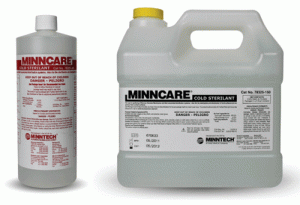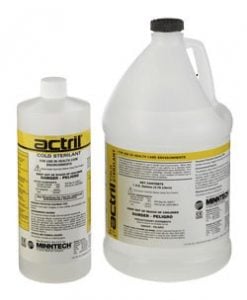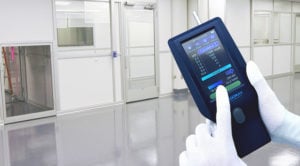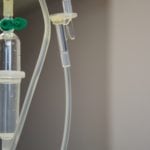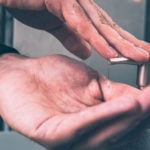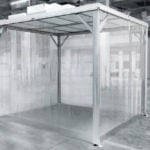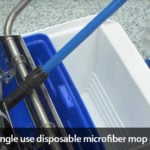Table of Contents
Some chemicals are more effective against hard-to-kill bacteria, microbes, and spores than others. Thus the active formulations are classified with unique names, class categories, and use cases. While for some these terms may seem trivial, selecting the appropriate chemical germicide requires understanding the pros and cons of various disinfectants vs sanitizers.
The information below will help you make educated choices on the proper use of disinfectants and sanitizers, reduce health hazards, and ensure adequate removal when targeting specific microbes, pathogens or viruses.
We’ll cover both sanitizers and disinfectants for general use, industrial, and also for clinical or critical decontamination of devices, instruments or environments.
Disinfectant and Sanitation Definitions for Food & Healthcare
Cleaning is the first and most essential process in any decontamination strategy. Surfaces and objects should be cleaned before disinfecting (MN Department of Health). Grime, grit, and bio films create protective layers for bacteria and viruses which render sanitation efforts less effective.
Cleaning removes visible soil and nonvisible microbes (e.g., bacteria, viruses, and protozoa) from an area or object (MN Health). Some of the microbes might be capable of causing disease in humans (called “pathogens”). Cleaning typically involves mechanical action such as wiping, scrubbing, or mopping combined with a general cleaner such as soap and water.
Detergents (i.e., surfactants) are compounds that possess a cleaning action. They are composed of both hydrophilic and lipophilic parts and can be divided into four groups: anionic, cationic, amphoteric, and nonionic detergents.
The cleaning process does not necessarily kill germs, but does reduce the proliferation and spread of bacteria by removing them through limited activity and physical mechanics. Not all cleaning processes require liquid detergents or solvents. Sticky mats and tacky rollers are also highly effective methods of contamination removal that do not require liquid.
Antimicrobial soaps contain additives that when applied to the skin reduce the number of microbial flora. Examples include alcohols, chlorhexidine, chlorine, hexachlorophene, iodine, chloroxylenol (PCMX), quaternary ammonium compounds, and triclosan.
Disinfectant vs Sanitizer
Disinfecting kills germs (not necessarily all of them) on surfaces or objects. Disinfecting works by using chemicals to kill germs on surfaces or objects. This process does not necessarily clean dirty surfaces or remove germs, but by killing germs on a surface after cleaning, it can further lower the risk of spreading infection.
Disinfectant means a substance, or mixture of substances, that destroys or irreversibly inactivates bacteria, fungi, and viruses, but not necessarily bacterial spores, in the inanimate environment.
Sanitizing lowers the number of germs on surfaces or objects to a safe level, as judged by public health standards or requirements. This process works by either cleaning or disinfecting surfaces or objects to lower the risk of spreading infection.
Sanitizer means a substance, or mixture of substances, that reduces the bacteria population in the inanimate environment by significant numbers but does not destroy or eliminate all bacteria. Sanitizers meeting Public Health Ordinances are generally used on food contact surfaces and are termed sanitizing rinses.
Sanitizer Efficacy Requirements
The following data is source from the EPAs Product Performance Test Guidelines
OCSPP 810.2300: Sanitizers for Use on Hard Surfaces—Efficacy Data Recommendations
(2) Evaluation of Sanitizing Success. The reduction of each test microorganism should be at ≥99.9% mean reduction over the 0-time control and the parallel untreated inoculated control.
- Non-food Contact Sanitizer: 99.9% reduction within 5 minutes
- Food Contact Surface Sanitizer Towelettes: 99.999% reduction in the number of each test microorganism within 30 seconds.
Food contact surface (FCS) towelettes are intended to be used to sanitize the following surfaces: hard non-porous tables, countertops (stainless steel, laminated, sealed ceramic) stove tops, interior and exterior surfaces of microwaves and refrigerators. FCS towelettes may not be used to sanitize the following food contact surfaces: utensils, glasses, food containers, dishes, cutting boards, cutting blocks, drain boards and food processing equipment.
References Above: (FDA) PART 880 — GENERAL HOSPITAL AND PERSONAL USE DEVICES
Simple Differences Between Sanitzers and Disinfectants
In simple terms, non food contact sanitizers are widely available and considered most appropriate for common surfaces and objects in actively occupied areas. These products include water soluble powders, liquids, and spray products. If used properly, the result is a 99.9% reduction of microorganisms on a treated surface versus those of an untreated control surface. As noted above, not all sanitizers are appropriate for items which contact mucous membranes, child toys, and food preparation or contact surfaces.
Below we’ll characteristics of disinfectants in greater depth. Generally, disinfectants are designed as more more aggressive anti microbial agents for hard surfaces, and only a select few are appropriate for general cleaning and household use. Most are designed as rapidly effective agents for complete decontamination in healthcare, industrial food supply, and medical device environments.
But first, let’s cover some more general concepts of chemical germicides and disinfectants.
What Is an Antimicrobial Pesticide?
Antiseptics and Germicides are used to prevent infection and decay by inhibiting the growth of microorganisms. Because these products are used in or on living humans or animals, they are considered drugs and are thus approved and regulated by the Food and Drug Administration (FDA).
DAVID MEIGS BEYER, PH.D. – Penn State
Antimicrobial pesticide is defined in section 2(mm) of FIFRA as a pesticide that is intended to: disinfect, sanitize, reduce, or mitigate growth or development of microbiological organisms; or protect inanimate objects, industrial processes or systems, surfaces, water, or other chemical substances from contamination, fouling, or deterioration caused by bacteria, viruses, fungi, protozoa, algae, or slime; and is exempt from or not subject to a tolerance…or a food additive regulation.”
EPA vs FDA Disinfectants
“In the United States, liquid chemical germicides (disinfectants) are regulated by EPA and FDA (A-1–A-3). In health-care settings, EPA regulates disinfectants that are used on environmental surfaces (housekeeping and clinical contact surfaces), and FDA regulates liquid chemical sterilants/high-level disinfectants (e.g., glutaraldehyde, hydrogen peroxide, and peracetic acid) used on critical and semicritical patient-care devices.”
“Disinfectants intended for use on clinical contact surfaces (e.g., light handles, radiographic-ray heads, or drawer knobs) or housekeeping surfaces (e.g., floors, walls, or sinks) are regulated in interstate commerce by the Antimicrobials Division, Office of Pesticide Programs, EPA, under the authority of the Federal Insecticide, Fungicide, and Rodenticide Act (FIFRA) of 1947, as amended in 1996 (A-4). “
Regulatory Framework for Disinfectants and Sterilants – Appendix A -2003
EPA Hierarchy of Disinfectants
EPA has established three main antimicrobial product categories based on the degree or level of antimicrobial activity. The three categories are sterilant, disinfectant and sanitizer.
Disinfection Hierarchy Draft >>> Overview of Disinfection Hierarchy
Disinfectant Categories
The EPA disinfectant category is further subdivided into three categories of product claim: limited spectrum disinfectant, broad-spectrum disinfectant, and hospital disinfectant.
For each category, EPA has established testing standards necessary to provide assurance of efficacy, including the test organism(s) a product must be evaluated against.
Limited Disinfectant – A disinfectant that is effective against only a specific major group of microorganisms (such as gram-positive [e.g., Staphylococcus aureus] or gram-negative [e.g., Salmonella enterica] bacteria) is considered to be a limited disinfectant.
Disinfectants for Medical Devices
“FDA, under the authority of the 1976 Medical Devices Amendment to the Food, Drug, and Cosmetic Act, regulates chemical germicides if they are advertised and marketed for use on specific medical devices (e.g., dental unit waterline or flexible endoscope). A liquid chemical germicide marketed for use on a specific device is considered, for regulatory purposes, a medical device itself when used to disinfect that specific medical device.”
Regulatory Framework for Disinfectants and Sterilants – 2003
General or Broad-spectrum Disinfectant – A disinfectant that is effective against both gram-positive and gram-negative bacteria (Staphylococcus aureus and Salmonella enterica) is considered to be a general or broad-spectrum disinfectant. General or broad-spectrum disinfectants have a wide variety of uses in residential, commercial, institutional, and other sites.
A general-purpose disinfectant is a germicide intended to process noncritical medical devices and equipment surfaces. A general-purpose disinfectant can be used to pre-clean or decontaminate critical or semicritical medical devices prior to terminal sterilization or high-level disinfection. Noncritical medical devices make only topical contact with intact skin.
Disinfectants for Hospitals
Hospital Disinfectant – A disinfectant that is a general or broad-spectrum disinfectant and also is effective against the nosocomial bacterial pathogen Pseudomonas aeruginosa is a Hospital disinfectant. These disinfectants are generally for use in hospitals, clinics, dental offices, or other healthcare-related facilities.
Pseudomonas aeruginosa is a common encapsulated, Gram-negative, rod-shaped bacterium that can cause disease in plants and animals, including humans. A species of considerable medical importance, P. aeruginosa is a multidrug-resistant pathogen recognized for its ubiquity, its intrinsically advanced antibiotic resistance mechanisms, and its association with serious illnesses – hospital-acquired infections such as ventilator-associated pneumonia and various sepsis syndromes. – WIKI
Read: USP Disinfectants and Sporicides
EPA Disinfectant Label Claims
A product that demonstrates efficacy within a category may convey label claims for the category itself (e.g., “hospital disinfectant”) and claims for the specific microorganisms required to be tested for that particular category (e.g., “Pseudomonas aeruginosa”). For claims against additional bacteria and viruses, EPA requires registrants to submit efficacy data for each individual microbe,
Unique Label Claims and Efficacy Test Protocols
“A registrant who wishes to add a claim for any specific public health microorganism other than those actually included in the product’s basic efficacy testing (e.g, Salmonella enterica, Staphylococcus aureus, and Pseudomonas aeruginosa), must submit efficacy testing for each such additional microorganism. For example, to add a claim for the human immunodeficiency virus 1 (HIV-1) to a hospital disinfectant, the registrant must perform and submit acceptable efficacy testing supporting any claims for its product against that specific virus.”
Pesticide Registration Manual: Chapter 4 – Additional Considerations for Antimicrobial Products
Other Types of Chemical Disinfectants
Non-sporicidal disinfectants may differ in their capacity to accomplish disinfection or decontamination. Some germicides rapidly kill only the ordinary vegetative forms of bacteria such as staphylococci and streptococci, some forms of fungi, and lipid-containing viruses, whereas others are effective against such relatively resistant organisms as Mycobacterium tuberculosis var. bovis, non-lipid viruses, and most forms of fungi.
Fungicide – A substance, or mixture of substances, that destroys fungi (including yeasts) and fungal spores pathogenic to man or other animals in the inanimate environment.
Tuberculocide – A substance, or mixture of substances, that destroys or irreversibly inactivates tubercule bacilli in the inanimate environment.
Virucide – A substance, or mixture of substances, that destroys or irreversibly inactivates viruses in the inanimate environment.
Pesticide Registration Manual: Chapter 4 – Additional Considerations for Antimicrobial Products
Disinfectant Categorization Level Chart
Low-Level Disinfectants
Low-level disinfectants are one of the most common approaches to general surface cleaning, sanitation, and disinfection. According to the CDC, low-level disinfectants can kill most vegetative bacteria, some fungi, and some viruses in a practical period of time (≤10 minutes).
Low-Level Disinfection kills most vegetative bacteria except M. tuberculosis, some fungi, and inactivates some viruses. The EPA approves chemical germicides as disinfectants in the US as labeled by “hospital disinfectants” or “sanitizers.”
70% IPA Wiper, Presaturated Meltblown Polypropylene
Presaturated Isopropyl Alcohol wipes are a common surface decontamination products for pharmaceuticals, healthcare, and medical device manufacturing.
Select re-sealable pouch to preserve the IPA and curb evaporation when not in use.
Clean gloves, notebooks, phones or any compatible material. Use with care: may degrade some types of plastics, LCD/LED coatings, and enamels.
Intermediate-level Disinfection
Intermediate and low-level disinfectants are formulated to use on fomites and environmental surfaces but lack the potency of a high-level disinfectant. Examples include bleach and alcohols.
For the most part, intermediate and low-level disinfectants can be safely used and, as with all disinfectants, the manufacturer’s instructions should be closely followed.
Intermediate-level Disinfection kills vegetative microorganisms, including Mycobacterium tuberculosis, all fungi, and inactivates most viruses. Chemical germicides used in this procedure often correspond to Environmental Protection Agency (EPA)-approved “hospital disinfectants” that are also “tuberculocidal.” They are used commonly in laboratories for disinfection of laboratory benches and as part of detergent germicides used for housekeeping purposes.
-
EPA-registered, one-step disinfectant and cleaner
-
Effective against some Human Coronavirus, Canine Coronaviruses and Transmissible gastroenteritis, which is also a type of Coronavirus for pigs.
-
For use with 100% polyester wipes only on hard, non-porous surfaces. Cellulose and cotton fibers deactivate any Quaternary disinfectant.
TexQ® Disinfectant does not yet have a 2019-nCoV kill claim for the latest novel corona virus strain.
Liquid Chemical Germicides
Liquid chemical germicides formulated as disinfectants may be used with mops or chemical foggers for the decontamination of large areas. The usual procedure is to flood the area with a disinfectant for periods up to several hours. This approach has traditionally been messy.
Advanced formulations have created more accessible green-friendly formulations with out requiring a final wipedown or representing a toxic hazard to laboratory staff.
Chemical germicides used for decontamination range in activity from high-level disinfectants (i.e., high concentrations of sodium hypochlorite [chlorine bleach]), which might be used to decontaminate spills of cultured or concentrated infectious agents in research or clinical laboratories, to low-level disinfectants or sanitizers for general housekeeping purposes or spot decontamination of environmental surfaces in healthcare settings.
High-Level Disinfectants
Most “high-level” disinfectants on the United States market are formulated for instruments, critical water systems, and medical devices. The intended use is not for environmental surfaces.
Liquid Chemical Sterilants
Sterilization describes a process that destroys or eliminates all forms of microbial life and is carried out in health-care facilities by physical or chemical methods. Steam under pressure, dry heat, EtO gas, hydrogen peroxide gas plasma, and liquid chemicals are the principal sterilizing agents used in health-care facilities.
When chemicals are used to destroy all forms of microbiologic life, they can be called chemical sterilants. These same germicides used for shorter exposure periods also can be part of the disinfection process (i.e., high-level disinfection).
Sterilization is intended to convey an absolute meaning; unfortunately, however, some health professionals and the technical and commercial literature refer to “disinfection” as “sterilization” and items as “partially sterile.”
A liquid chemical sterilant/high level disinfectant is a germicide that is intended for use as the terminal step in processing critical and semicritical medical devices prior to patient use. Critical devices make contact with normally sterile tissue or body spaces during use. Semicritical devices make contact during use with mucous membranes or non-intact skin.
Cold Sterilants
Cold sterilants are high-level disinfectants that work at room temperature. Many sterilization methods require high-temperature heat cycles (autoclave sterilization) or extended periods of increased room temperature for effective decontamination (vaporized hydrogen peroxide). Heat can adversely affect many types of plastics and composite materials, therefore a cold sterilant offers a cost-effective and non-intrusive alternative.
Cold Sterilant Cleaning Solutions
Concentrated Sterilant for Water Systems
Prediluted Sterilant for Surfaces
Actril Cold Sterilant is designed for hard surfaces common in biopharmaceutical facilities, therefore it’s ready to use and pre-diluted. It maintains compatibility with most materials found in general and high-performance environments. The Actril formula is eco-friendly because its raw materials are not characterized as carcinogenic, mutagenic materials, or toxic. It’s safe for the environment and is completely biodegradable and will decompose into oxygen, water, and acetic acid.
Beyond its use in medical device manufacturing, it is also appropriate for poultry processing plants, canneries, dairies, breweries, wineries, including food and beverage facilities.
The classification of a sanitizer or disinfection has implications for its use, but also when considering necessary protective measures for end-users and the environment. Always take the proper safety precautions, read labels, and follow the intended manufacturer use.
Production Automation Corporation (PAC) is a factory-direct cleanroom supplier for environments, supplies, apparel, and furniture.
Every PAC product is backed by dedicated customer service, sales support, and in-house specialists.
Need help with a technical manufacturing solution? We’re the specialists in your back pocket.
Shop the PAC website or our CleanRoomProducts.com specialty division for factory-backed products curated by factory-trained specialists.
- We diligently choose suppliers and sell only direct authorized products
- We 100% stand behind all of our products
- Enjoy great pricing and great customer service
- Select from thousands of items on our site
- Customize your selection with accessories
- Get the best possible pricing available from any cleanroom specialty supplier
- Our product specialists have factory training on the items we sell
Related Posts
-
ISO 13485:2016 Medical Devices
ISO 13485 is designed for use throughout the life cycle of a medical device. It supports each stage of medical device development and operation from initial concept to production and disposal. The standard helps internal…
-
Why 3-Ply Face Masks are Meaningful Alternatives to N95 Masks
How effective are surgical masks and procedural masks as alternatives to N95 masks? Where can I find a reliable supplier of face masks?
-
Mobile Hand Washing Stations and Sinks for Manufacturing
Portable hand sinks have internal water supply and waste water storage. The standalone unit with powered pump supply requires no additional plumbing, drains, or inlets.
-
Plexiglass Sneeze Shields for Workers and Protective Dividers
Where can I find Plexiglas sneeze shields and dividers for workstations, kiosks, and checkout lines?
-
Types of Cleaners | Disinfectants for Industrial, Hospitals, or Medical Devices. How Are They Used?
This article defines, contracts, and compares FDA and EPA requirements for the efficacy of various chemical germicides, sterilants, and disinfectant chemicals.
-
Negative Pressure Rooms for Hospitals and Emergency Rooms
What are the options for temporary negative pressure triage and emergency room structures?
-
What's the Correct Way to Wipedown a Surface? What's the Advantage of Microfiber Wipes?
What is the proper technique for wipedown and sanitation of surfaces? Why is a microfiber wipe most effective for viruses and infection control?
-
How Do I Properly Wipe Down Surfaces in Cleanrooms and Labs?
What are the proper steps for wiping surfaces, biological isolators, and laminar flow cabinets, and excess hazardous drugs?




